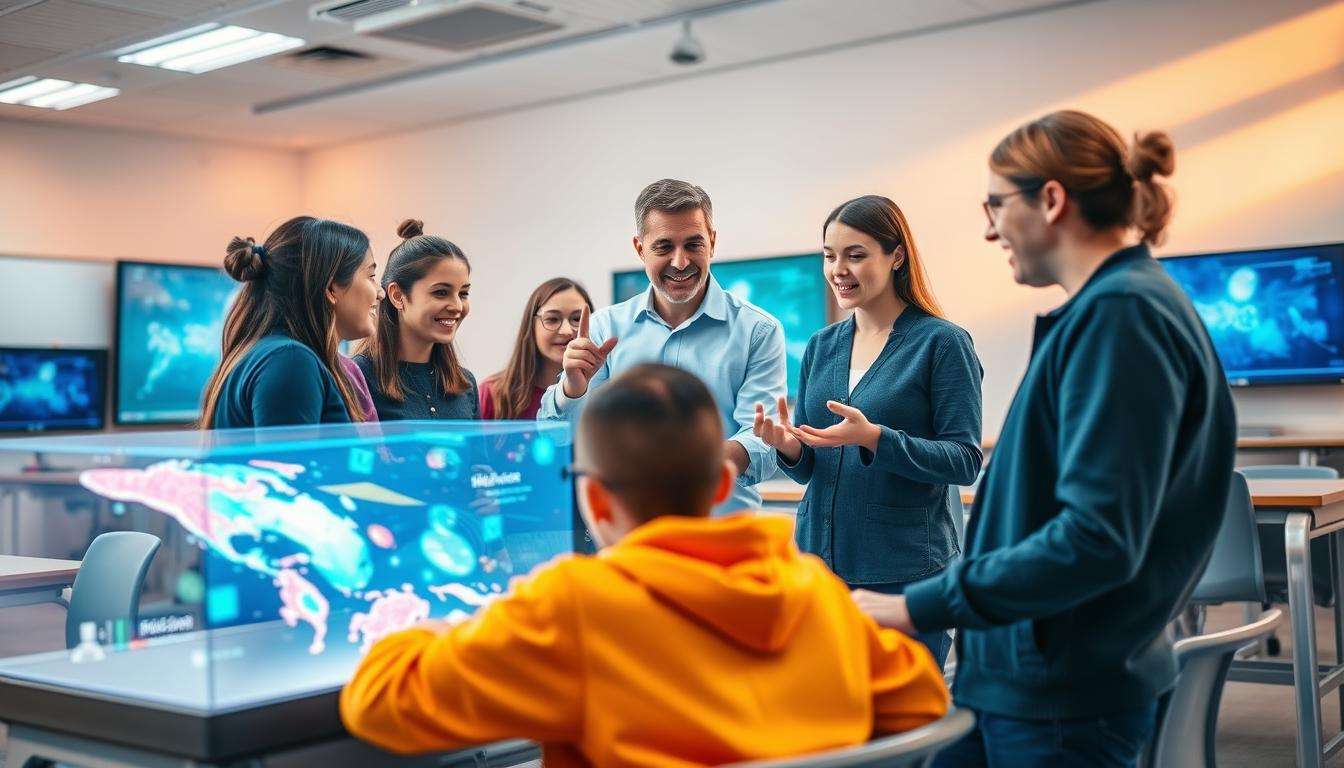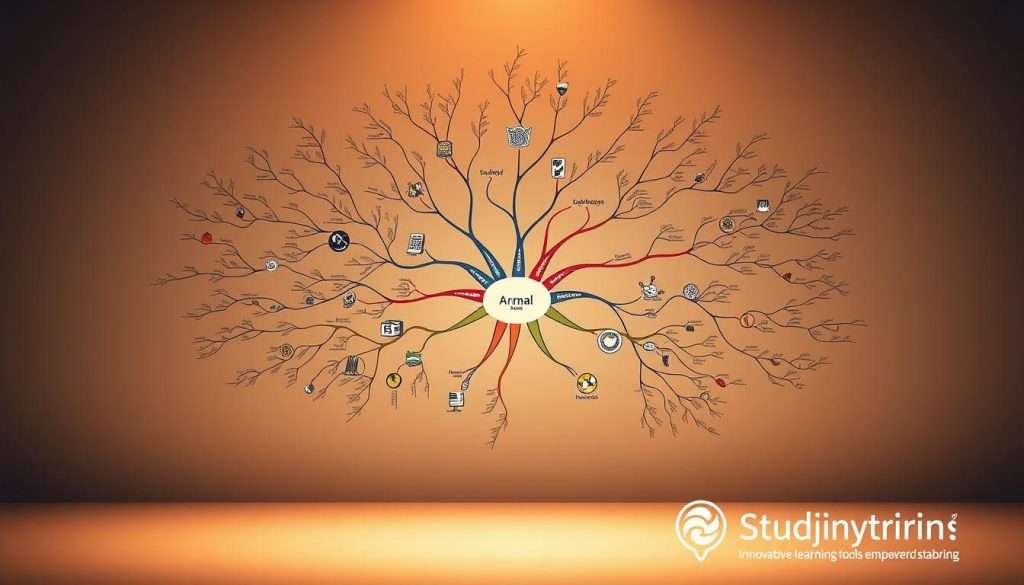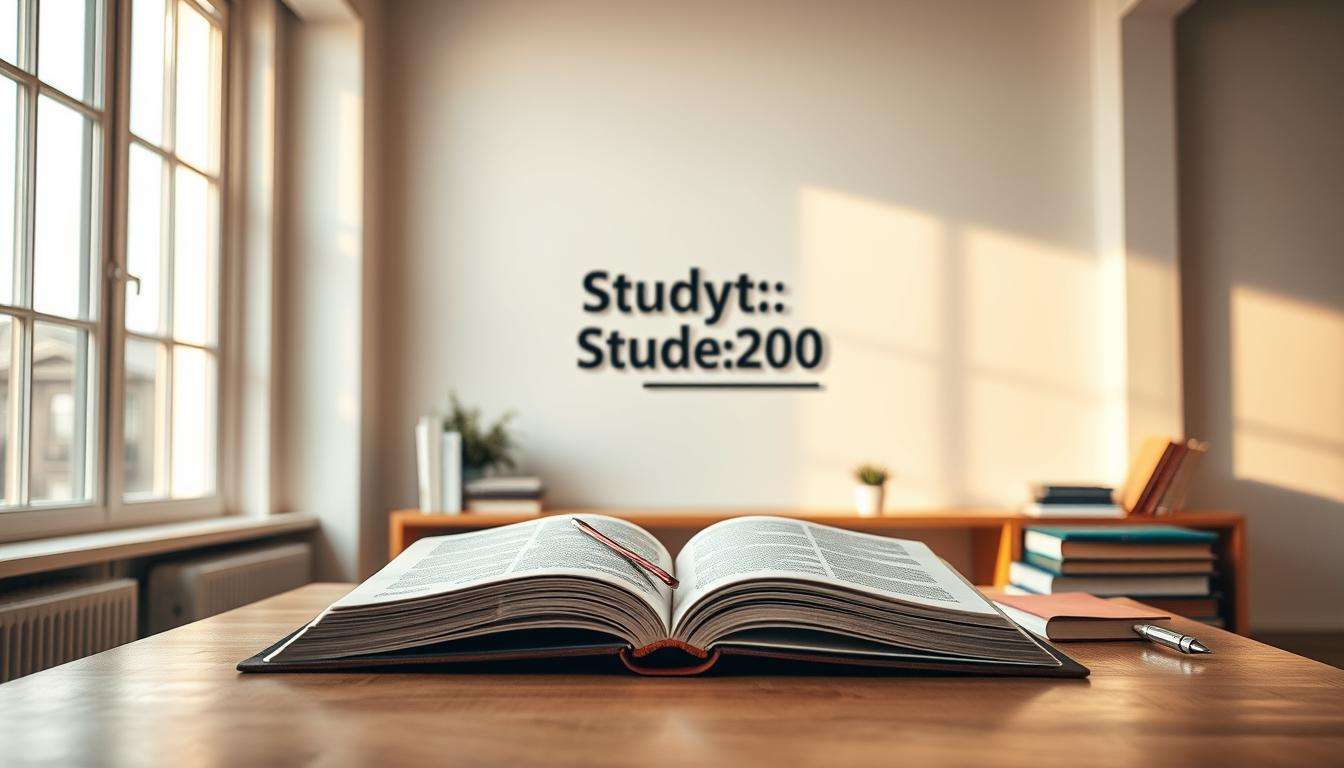We’ve all been there: studying for a test, and then your phone buzzes. You check it, and before you know it, you’ve wasted 30 minutes on social media. Sound familiar? You’re not alone. Distractions really hurt our learning, messing with our attention, memory, and comprehension.

As students, we must stay on track to reach our goals. But distractions are everywhere, making it hard to stay focused. Studies show that distractions really hurt how well we learn, making it tough to remember things and do well on tests.
Key Takeaways
- Distractions affect cognitive processes, including attention and memory.
- Effective learning requires staying focused.
- Digital distractions are a major obstacle to learning.
- Strategies can help minimize distractions and improve focus.
- Staying motivated is key to overcoming distractions.
Understanding the Modern Distraction Landscape
The modern classroom is full of distractions, both digital and physical. These can stop students from focusing and learning. Students face many distractions that affect their ability to stay focused.
Digital vs. Physical Distractions in Today’s Learning Environment
Digital distractions, like social media and phone notifications, are big hurdles for focused learning. Technology distractions and student focus often clash. Physical distractions, such as background noise and talking peers, also pull students’ attention away.
The Evolution of Attention Challenges in Education
Distractions in schools have changed over time. From chalkboards to digital whiteboards, learning environments have grown more complex. It’s important to understand this change to find ways to reduce distractions.
Why Focus Matters More Than Ever Before
In today’s world, being able to focus is more important than ever. Minimizing distractions in the classroom is not just about better grades. It’s about developing a skill that helps students all their lives. By understanding distractions, educators and students can make learning more focused and effective.
Some ways to reduce distractions include:
- Creating technology-free zones or times
- Using website blockers or apps to stay focused
- Setting up a learning environment that encourages focus
The Dangers of Distraction in Learning: Scientific Evidence
Studies show that distractions harm our learning. They make it harder to understand and remember new things. It’s important to know how distractions affect us as we learn in today’s world.
Cognitive Load Theory: How Distractions Overburden the Brain
Our brains can only handle so much information at a time. Distractions add to the extraneous cognitive load, making learning more difficult. Research proves that too much cognitive load hurts our learning efficiency and understanding.
The Myth of Multitasking and Learning Performance
Multitasking is thought to be beneficial, but it’s not. Studies show it actually hurts our learning by splitting our attention. Our brains struggle to handle complex tasks while doing multiple things at once.
Neurological Impact of Constant Interruptions
Constant interruptions affect our brains deeply. They cause stress hormones like cortisol to be released, which can mess with our memory and focus. Research also shows that too many interruptions can change our brain’s structure, affecting areas that handle attention.
| Impact | Description | Effect on Learning |
|---|---|---|
| Cognitive Load | Increased extraneous load due to distractions | Reduced learning efficiency |
| Multitasking | Divided attention during learning tasks | Impaired learning performance |
| Constant Interruptions | Release of stress hormones, changes in brain structure | Impaired memory formation, reduced focus |
Distractions have many negative effects on learning, as science shows. By knowing these effects, we can work to reduce distractions and enhance our learning.
How Distractions Sabotage Academic Performance
Distractions are a big problem in modern education. They can be things like social media or talking classmates. They all take our focus away from what we need to do.
Reduced Comprehension and Information Retention
Distractions slow down our learning and make it harder to understand and remember things. Studies show that distractions really hurt our reading skills and memory. Our brains can’t handle learning when we’re split between different things.
Extended Learning Time and Decreased Efficiency
Distractions also make us less efficient. “Multitasking is a myth”, some say. Trying to do too many things at once makes us take longer to finish our work. This can lead to frustration and make things worse.
The Correlation Between Distraction and Lower Grades
Distractions often mean lower grades. Studies show that students who get distracted while studying do worse in school. Let’s look at some examples to see why.
Case Studies and Research Findings
Many studies have looked at how distractions affect grades. For example, one found that students who used laptops for fun in class did worse than those who didn’t. Another study said that even having a phone nearby can hurt how well we think, even if we’re not using it.
Long-term Educational Consequences
Chronic distraction can have serious long-term effects.
“Chronic distraction can lead to a habitual state of continuous partial attention, which can negatively impact learning and cognitive development.”
This can mean not just lower grades but also trouble learning and adapting in school and later in life.
Identifying Your Personal Distraction Triggers
The first step to beating distractions is to know what distracts you. Everyone has different things that take their attention. Knowing yours is crucial for minimizing distractions in the classroom and better learning.
Conducting a Personal Distraction Audit
To find out what distracts you, start a personal audit. For a week, write down when you get distracted, what distracts you, and how it impacts your study time. Use a notebook or a mobile app to log this info. Ask yourself:
- What were you doing when you got distracted?
- What was the distraction?
- How long did it take you to refocus?
Common External and Internal Distraction Patterns
Digital distractions are big problems in school, with social media, email, and texts being major distractions. But, things like noise and stress and anxiety also distract us. Knowing if your distractions are from outside or inside will help you fight them better.
Creating Your Distraction Profile
After you’ve collected data on your distractions, make a profile to sum it up. List your most common distractions, when you’re most distracted, and any patterns. This profile will help you make plans to minimize technology distractions and improve student focus.
By understanding and tackling your personal distractions, you’ll be more focused and reach your academic goals.
Creating a Distraction-Free Learning Environment
Turning your study area into a distraction-free zone is key for success. We must make a space that helps us focus and be productive.
Physical Space Optimization Techniques
First, make your study space better. This means controlling noise and removing things that distract you visually.
Noise Management Strategies
Noise can really get in the way. Noise-cancelling headphones or background music can block out annoying sounds. As Cal Newport said, “The key to focus is a supportive environment.”
“The key to maintaining focus is to create an environment that supports it.”
Visual Distraction Elimination
Too much visual clutter can pull your attention away. Clear out your study area and use organizational tools to keep it neat. A standing desk or a comfortable, ergonomic chair can also help you stay focused and avoid getting tired.
Digital Environment Management
In today’s world, managing digital distractions is as crucial as making your physical space better.
Effective Use of App and Website Blockers
Apps like Freedom and Cold Turkey can block distracting sites and apps. They help you stay focused and avoid putting things off.
Setting Up Notification-Free Study Sessions
Make sure your devices are silent during study time. Use “Do Not Disturb” mode to turn off notifications and cut down on digital distractions.
By using these tips, you can make a study space that helps you reach your goals. The most important thing is to be mindful of your study area and how you use digital tools.
Managing Social Distractions in Learning Contexts
Modern learning comes with its own set of challenges, and social distractions are a big one. You might find yourself always connected to friends and family online. Or, you could get easily caught up in the latest trends. It’s key to manage these distractions to reach your academic goals.
Setting Boundaries with Friends and Family
Setting clear boundaries with friends and family can help a lot. Tell them when you’re studying and ask them to let you focus. Saying, “I’m studying now, can we catch up later?” can really help.
Collaborative vs. Solo Study: Making the Right Choice
Choosing whether to study alone or with others is important. Group study can be good for some topics, but it can also distract. Think about your learning style and the subject when deciding.

Handling Social Media Pressure During Study Time
Social media can be a big distraction. Use apps to block social media sites during study time. Also, set specific times to check your notifications. Every minute is crucial when you’re trying to meet a deadline!
By using these strategies, you can handle social distractions better. It’s about finding the right balance and being intentional with your study time.
Effective Time Management Strategies to Combat Distractions
In today’s world, distractions are everywhere. But, using smart time management can really help you learn better. It’s not just about doing more in less time. It’s about making a system that keeps you focused on what’s important.
Implementing the Pomodoro Technique for Focused Learning
The Pomodoro Technique is simple. You work in 25-minute blocks, then take a 5-minute break. This keeps your focus sharp and stops burnout. By setting a specific time for studying, you avoid getting sidetracked.
Strategic Time Blocking for Different Types of Learning
Time blocking means setting aside big blocks of time for important tasks. By planning out your study schedule, you can stay productive and avoid distractions.
Using Deadlines and Accountability Systems
Deadlines help keep you moving forward in your studies. Setting achievable deadlines adds a sense of urgency that keeps you motivated.
Study Partners and Accountability Groups
Studying with a partner or joining a group adds extra motivation. These groups create a sense of teamwork and accountability, helping you stay focused on your goals.
Self-monitoring Tools and Techniques
Using tools like planners or apps helps you track your progress. Regularly checking your performance lets you tweak your study plan to learn better.
| Time Management Technique | Description | Benefits |
|---|---|---|
| Pomodoro Technique | 25 minutes of focused work + 5-minute break | Improved concentration, reduced burnout |
| Time Blocking | Scheduling large blocks of uninterrupted time | Enhanced productivity, structured learning plan |
| Deadlines | Setting realistic completion dates for tasks | Increased motivation, sense of urgency |
By using these time management strategies every day, you can cut down on distractions and do better in school. The most important thing is to find a method that fits you and stick with it.
Developing Mental Focus: Practical Cognitive Training
Today, with so much information around us, it’s crucial for students to learn how to focus. It’s not just about ignoring distractions. It’s about strengthening your mind to stay focused and reach your goals.
5-Minute Mindfulness Exercises for Students
Mindfulness exercises can greatly improve your focus. Try this easy 5-minute exercise: Sit comfortably, close your eyes, and focus on your breath. If your mind drifts, gently bring it back to your breathing. This practice helps you manage distractions and improve your learning outcomes.
Progressive Attention Span Building Activities
To increase your focus, start with short study sessions (25 minutes) and gradually add more time. Use a timer to stay on track. This method helps you build lasting focus.
Metacognitive Strategies for Sustained Focus
Metacognitive strategies mean being in control of your thoughts. This includes planning your learning, checking your progress, and reviewing your results.
Self-questioning Techniques
Ask yourself questions like “What am I trying to achieve?” or “Am I staying on track?” This self-questioning keeps you focused and ensures you meet your learning goals.
Focus Recovery After Distraction
If you get distracted, acknowledge it and refocus. Use a “stop and refocus” technique: take a deep breath, acknowledge the distraction, and gently return to your study material.

Technology Tools That Enhance Focus Rather Than Distract
Technology is often seen as a distraction, but there are tools that help you focus. We’ll look at some top tools that can keep you on track with your studies.
Focus-Enhancing Applications for Different Learning Styles
Everyone learns differently, and there’s an app for that! For those who like pictures, MindMeister helps make mind maps. If you prefer listening, Podcast Addict is great for educational podcasts. And for hands-on learners, Duolingo makes learning fun and interactive.
Digital Learning Assistants That Streamline Study
Digital helpers can save you time on boring tasks. You can use Trello or Asana to organize tasks. And Google Calendar sends reminders to keep you on schedule.
Productivity Tracking Software for Self-awareness
Knowing how you spend your time is key to being more productive. RescueTime tracks your app and website use. It gives you insights into your productivity.
Distraction-blocking Technology Solutions
Blocking distractions can help you stay focused. Tools like Freedom or Cold Turkey block distracting sites and apps. They help you stay on track.
Using these technology tools can make your learning environment more focused and productive. It’s about finding the right tools for you and using them wisely.
Conclusion: Building Lasting Focus Habits for Academic Success
Staying focused is key in today’s learning world. By understanding distractions and finding ways to avoid them, you can boost your focus and grades.
We’ve looked at ways to keep your learning space free from distractions. We’ve also talked about handling social distractions and improving your mental focus. Using these methods can help you learn better and get better results.
Creating lasting focus habits takes effort and patience. But the benefits are huge. By using techniques like the Pomodoro Technique and managing digital tools, you can stay focused and reach your academic goals. Start using these strategies now and see your productivity and grades improve!
FAQ
What are the most common distractions in learning?
Common distractions include digital ones like social media and email. Physical distractions are also common, such as noise and family members.
How do distractions affect academic performance?
Distractions can lower grades and make learning take longer. They also make it harder to remember what you’ve learned.
What is Cognitive Load Theory, and how does it relate to distractions?
Cognitive Load Theory says distractions make our brains work too hard. This makes it harder to learn and remember things.
Can technology be used to enhance focus rather than distract?
Yes, technology can help you stay focused. There are apps and software designed to keep you on track and reduce distractions.
How can I identify my personal distraction triggers?
To find out what distracts you, do a personal distraction audit. Track when and where you get distracted. This helps you understand your patterns.
What are some effective strategies for managing social distractions?
To manage social distractions, set boundaries with friends and family. Choose whether to study alone or with others. Also, handle social media wisely during study time.
How can I create a distraction-free learning environment?
To make a distraction-free study space, optimize your physical area and manage digital distractions. Use noise management tools and app blockers. Set up study sessions without notifications.
What is the Pomodoro Technique, and how can it help with focus?
The Pomodoro Technique involves focused 25-minute work sessions, followed by a 5-minute break. It helps improve focus and avoid burnout.
How can mindfulness exercises improve my focus?
Mindfulness exercises, like 5-minute sessions, can boost your attention span. Regular practice leads to better focus and learning efficiency.
What are some strategies for building lasting focus habits?
To build lasting focus habits, practice regularly and stay aware of your focus. Develop a routine, set clear goals, and use software to track your progress.











